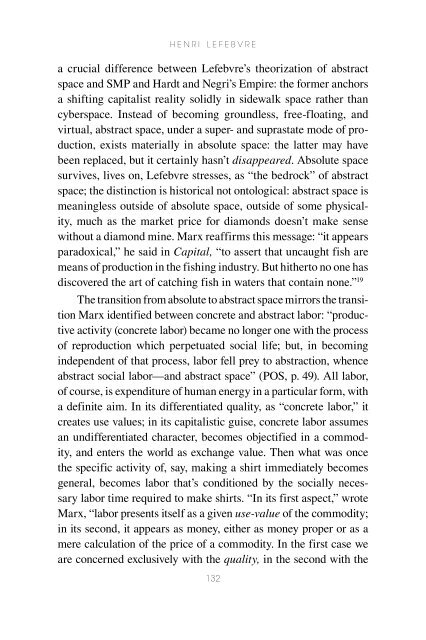Henri Lefebvre: A Critical Introduction - autonomous learning
Henri Lefebvre: A Critical Introduction - autonomous learning
Henri Lefebvre: A Critical Introduction - autonomous learning
You also want an ePaper? Increase the reach of your titles
YUMPU automatically turns print PDFs into web optimized ePapers that Google loves.
H e n r i L e F e b v r e<br />
a crucial difference between <strong>Lefebvre</strong>’s theorization of abstract<br />
space and SMP and Hardt and Negri’s Empire: the former anchors<br />
a shifting capitalist reality solidly in sidewalk space rather than<br />
cyberspace. Instead of becoming groundless, free-floating, and<br />
virtual, abstract space, under a super- and suprastate mode of production,<br />
exists materially in absolute space: the latter may have<br />
been replaced, but it certainly hasn’t disappeared. Absolute space<br />
survives, lives on, <strong>Lefebvre</strong> stresses, as “the bedrock” of abstract<br />
space; the distinction is historical not ontological: abstract space is<br />
meaningless outside of absolute space, outside of some physicality,<br />
much as the market price for diamonds doesn’t make sense<br />
without a diamond mine. Marx reaffirms this message: “it appears<br />
paradoxical,” he said in Capital, “to assert that uncaught fish are<br />
means of production in the fishing industry. But hitherto no one has<br />
discovered the art of catching fish in waters that contain none.” 19<br />
The transition from absolute to abstract space mirrors the transition<br />
Marx identified between concrete and abstract labor: “productive<br />
activity (concrete labor) became no longer one with the process<br />
of reproduction which perpetuated social life; but, in becoming<br />
independent of that process, labor fell prey to abstraction, whence<br />
abstract social labor—and abstract space” (POS, p. 49). All labor,<br />
of course, is expenditure of human energy in a particular form, with<br />
a definite aim. In its differentiated quality, as “concrete labor,” it<br />
creates use values; in its capitalistic guise, concrete labor assumes<br />
an undifferentiated character, becomes objectified in a commodity,<br />
and enters the world as exchange value. Then what was once<br />
the specific activity of, say, making a shirt immediately becomes<br />
general, becomes labor that’s conditioned by the socially necessary<br />
labor time required to make shirts. “In its first aspect,” wrote<br />
Marx, “labor presents itself as a given use-value of the commodity;<br />
in its second, it appears as money, either as money proper or as a<br />
mere calculation of the price of a commodity. In the first case we<br />
are concerned exclusively with the quality, in the second with the<br />
132
















